Chef Ben Moenster brings Herbst roaring back to life.
Dill pickle fried chicken, curried Brussels sprouts, smoked cheddar white chocolate foam, and glazed beef cheek make Herbst my go to spot in the dead of winter.
Part 1: The “Ilia” team.
I don’t go to restaurants in their first 90 days as a general rule. Every year, I make a few exceptions, usually when I’m traveling and think the restaurant is one I will love, with a team I already know can deliver.
In 2024, for example, I went to four restaurants in their first 90 days. Total.
I don’t go to restaurants in their first 90 days for lots of reasons. Here are a few of them:
Restaurants need you the least when they open in a swirl of hype.
Most restaurants take 90-180 days to figure out their flow, which means if you arrive at day 180, you are likely to have a better experience. But sometimes days 1-90 are when an established chef/owner with multiple restaurants is around and then they rarely step foot in the door, so sometimes day 45 runs like a dream and day 180 runs off the rails. Either way, going on day 180 shows you a better picture of what that restaurant is.
I do not engage in the opening hype cycle and do my best to keep restaurants I love alive by going to places that have my trust instead.
Getting added into my regular rotation takes something special. I know the restaurants that hit again and again and again—I return to them.
So when a local chef told me I had to go to Herbst (had to) in its first 90 days, I ignored him the first, second, third, and fourth time.
Then he Venmoed me money and said, “Go.” This, along with another chef that same day telling me I would love it, sent me on my merry way to St. Paul.
When I walked into the space in late spring, it was gleaming. The brightest local restaurant I’d been in in a long time, sunset caught the red windows and set a pink-ish hue across the bar. The center piece, often Instagrammed, is a floral lamp that looks like a piece of art. And the art itself has humor (throw tomato soup or mashed potatoes at me reads one canvas).
To me, the true art is in the finer details. The mismatched wooden chairs that make it feel like a home and not a restaurant. The rounded edges throughout, including the booths in the corners. The under lighting at the bar which softens the space at night. And those red window panes at the top of the windows, where snow dances like a movie in winter and where the sun turns red at sunset in summer. The materials are high quality: leather with solid stitching, industrial velvet. It’s a restaurant built to last.
The design feels Scandinavian meets Midwest farm house with a touch of glam. It looked different than the other new build restaurants here, which all seem to be built by the same designer with the same vision. In the Twin Cities, design rarely seems to mean anything about what the restaurant is and seems to mean more about who they know or a mark of their lineage. Take a photo of goldware against some kind of green background and you could be anywhere.
I didn’t do any research on my way in. I don’t when I look at a local new restaurant, usually (when I travel, I do my research most of the time, but sometimes, I throw a dart). For local restaurants, I avoid the press almost entirely until about visit three, so that I can form my own opinion.
I read the local food press every week on Wednesday and categorize the articles on new places to read later. I normally read them on my third visit while inside the restaurant, comparing another writer’s experience with my own.
I didn’t know much about the owners or the chef team except where they came from. Opening chef Eric Simpson worked at one my favorite restaurants in the country, Lilia; Chef Ingrid Norgaard worked at Tilia; and co-owner Jörg Pierach is a Tilia co-founder meaning it was the “ilia” team to me. At the time, I did not know the background of Angie Pierach, who was a former teacher before transitioning into the job of full-time parent and now into the face that often greets me at Herbst. On my first visit, I didn’t even know that the owners shared my love of farm stands and that one singular farm stand inspired them (it’s my dream to own a rural small town farm stand with everything from canned whole tomatoes to mayo made in house, inspired by Rosie).
All I knew was the names of a few chefs and that two people I trusted told me, “Go.”
The first bite I had was the ricotta toast. It floored me. It was simple perfection, with housemade bread that had a nuttiness to it that screamed heirloom flour. Then I had their lumache, which at the time had heat to it. It had pesto full of herbs and serrano and housemade pasta cooked perfectly.
The restaurant reminded me of Lilia. I’ll be honest—it reminded me of Lilia in a way I felt derivative, but it didn’t matter to me, because I love Lilia. Lilia is fresh pastas, stellar breads (their ramp focaccia is one of my favorite breads of all time), and gorgeous vegetables, with just a touch of meat. Herbst, when it opened, felt just like that.
The potential for the farm stand reminded me of home—not this home, but my second home. The Hudson Valley and the Catskills are speckled with restaurants that have stands like this. I spent five years there and I miss those types of stands immensely. Every year I go back to the Hudson Valley with an entire suitcase to bring things home from those stands. I felt the vision at Herbst. I believed in it.
“Okay,” I told the chefs who sent me, “You were right.”
I brought all my friends in those few short months. I have a deep and lasting memory of a friend telling me all the reasons why I am worth loving, worth dating, as I cried over a cowboy at the bar. Since that first tearful journey, I’ve cried at Herbst a lot (over more than one cowboy, too).
I think every single girl needs three restaurants: (one) a place you can go after a bad date, (two) a place you can go after a break up, and (three) a place you can go when a guy stands you up or cancels after you already got cute.
Martina filled the first role.
Myriel filled the second.
Herbst filled that third spot for me, meaning I came to this place when, in the middle of doing my winged eyeliner, a man said, “Sorry, I can’t make it tonight,” something that happened far too often on dating sites in 2024 (and funnily enough, something that happened with one of the men who sent me to Herbst in the first place).
Herbst lodged itself into my heart, because I put it there. I gave it a role of importance. Herbst meant something to me. Because restaurants aren’t just about the food—they’re about memories.
Part 2: The in between.
Then Simpson left.
I know why—and all that matters for this piece is that the reason why gave me great respect for the owners.
In the interim, I kept going back to Herbst under Norgaard’s leadership. I ate a pasta dish with so many poppyseeds in it that the texture was gritty and with gruyere that wasn’t fully incorporated into the sauce. I had a smashed turnip and daikon with Juniper dish that still haunts me, because it tasted like Bath and Body Works, leaving me to this day afraid to order Juniper and unsure if I’m a reliable judge of N/A gins due to an aversion I never had before.


I kept going back (even ordering the turnips and daikon a second time), searching for the Herbst I ate at in the beginning. It was so much magic in the early days, I had to keep searching for it. Every dish had too much of something (juniper, poppy seed, vinegar, herbs, oil)—and every dish didn’t have enough of something (salt).
Some nights, I went and sat at the bar, waiting for the menu to change over, eating only Pastry Chef Maria Beck’s iconic toasted milk bread with grape granita or her miso cheesecake while drinking Herbst’s god tier N/A drinks. (Chef Beck left Herbst in 2024—it was a significant loss.)
In the dead of winter, I kept coming, normally later in the night, normally alone. The dining room was usually empty.
One local food writer put it this way to me privately, “They’re putting out a menu too ambitious for the team to execute.” That food writer was right, but I couldn’t stop. I was all in on this place. I loved it so much. And when a place has ambition, I just have to believe they’ll get there—most of the time.
Then Norgaard left and things got really messy. Literally. It was a mess in the kitchen. I sat at the chef’s counter one night and watched an obviously very talented team struggling without clear leadership.
I was heartsick over Herbst. I loved how it opened with a clear and distinct identity. I loved the dream of the farm stand. I loved that it wasn’t more of the same carbon copy design and menu. It felt like it could inspire other people to open their own restaurants in their own voice and their own style. I didn’t want that to die. I really didn’t.
“Stop going,” a friend told me, “You’re always so disappointed.”
I couldn’t.
I wrote a review. I refused to publish it. I sat on it. I promised myself that whenever they got their next permanent chef, I’d publish it for good or for bad.
So when I found out Chef Ben Moenster took over, I quietly said, “Shit,” not because I don’t like his food, but because I was worried bringing in someone from Spoon and Stable would kill the things I loved about this place, no matter how messy it had gotten.
I think of Spoon and Stable as understated, relatively classic, and French-American East Coast influenced. That’s a mouthful, but it’s what I’ve got.
I do not think of it as Midwestern—not at all—though in recent years, I think Minneapolis has a skewed view of Midwestern cuisine as most restaurants of acclaim are opening with East Coast and French influenced chefs. I digress.
This is not to hate on that style of food (Spoon and Stable is great at what it does), but it is to say that Herbst isn’t that.
But also, it is to say, when I’ve had dishes that try to burst outside of that very mouthy description I’ve made up for Spoon and Stable, they’ve fallen flat. My worst pasta of 2023 was at Spoon and Stable, a bold blood orange goat cheese dish that straight up tasted like Sunny D mixed with Mac n Cheese.
This dish was so bad, I sent people money to order it when they told me they were going to Spoon, because I was sure I was wrong. I wasn’t. Everyone confirmed for me that the dish did indeed taste like Sunny D and Kraft Mac.
I’m so sorry, but I literally bought Sunny D and made Kraft Mac pasta, mixed those two things together, and brought it to Spoon and Stable in my purse to taste it side by side in the bathroom after I got the pasta boxed to go. Look, I might be a little insane, but I was not wrong. I stood in the bathroom with the stall door shut and said, “Yeah that’s dead on.” A different version of this dish is still on the menu and I hope to god they worked out the kinks but you won’t catch me ordering it.
To me, Spoon and Stable is beautiful cream or butter based sauces and herbs de provence heavily featured throughout the menu and vichyssoise and mostly, to me, it’s Alexandra Motz’s desserts. That’s what they do best. When they stray from that, they don’t nail it most of the time.
Their creative takes on savory haven’t landed the same way as their classic leaning dishes have. They sometimes seem to be trying to fit into two worlds at once: Spoon and Stable’s world and the cutting edge. But those worlds are at odds and Spoon and Stable fits into its own classic world with so much grace, it doesn’t need to leave it.
To me, Herbst is wilding out. In all Herbst’s too muchness, it was trying to be something. I felt it. I saw it. For a moment, I tasted it.
The identity was unique and a bit whacky, very playful. The problem wasn’t concept—the problem was dialing it in. Whenever I ate something at Herbst in the space between Chef Simpson and Chef Moenster, I was begging someone (anyone!) to taste the dishes. I thought each of them, on paper, were beautiful. I kept remaking them in my home. Dish after dish, trying to fix them, trying to prove to myself that the problem wasn’t the creative menu but execution.
When Chef Moenster took over, I was worried that upon walking into Herbst, I would be walking into Spoon and Stable Lite—and I don’t want to go to Spoon and Stable Lite when a man stands me up. I want to go to Herbst.
My first visit was a whirlwind.
I went with my boyfriend Greg who (full disclosure) used to work with Chef Moenster. At this point, no one in the restaurant knew what I was up to, or with all the turnover, that I was even a former semi-regular who always seemed a little sad. My first visit at a non-tasting menu restaurant isn’t one I review. I take things in. I set the scene. I think. I eat. I watch.
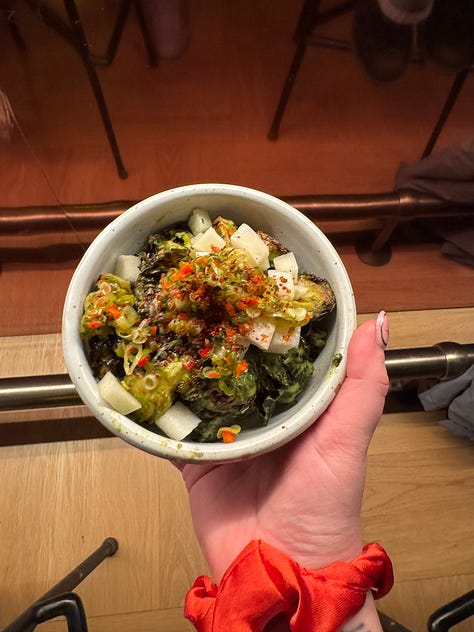
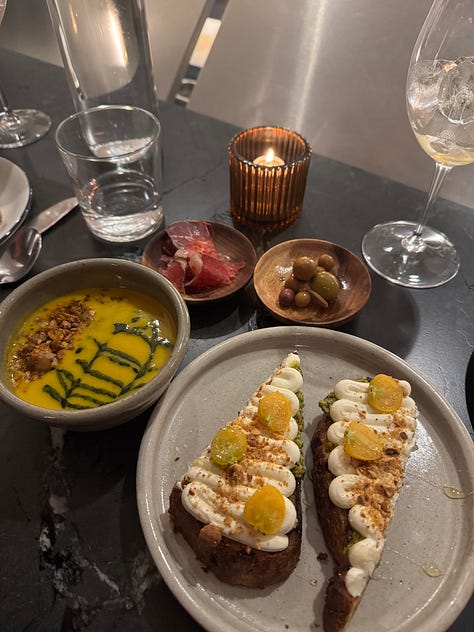
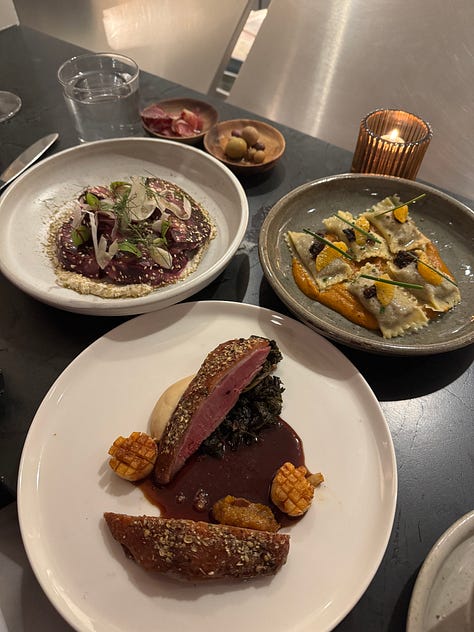
One kid working the line was singing songs all night to himself, just totally rocking out. Grant Wann, a young chef also on the line, was Tasting every dish with a capital T. Chef Moenster went from running expo to the back kitchen to the line. Salt was being used generously and often. The first thing my boyfriend and I both noticed was that the kitchen was gleaming. Neither of us had seen a kitchen that clean in a long time. The next thing I noticed was how often they were tasting, with more than once Moenster asking his team, “Have you tasted that?” (Restaurant lore and movies show chefs asking this question a lot—as a woman who hangs out in open kitchens, I know that very often dishes go untasted from open-close, if not long before.)
They were in the weeds, with dishes taking longer than I knew they wanted them to, but they were taking it one plate at a time.
We sat at the chef’s counter and dishes came at us over the course of two hours, some we paid for, some were comped (You can view my comp policy, my ethics, and other bits about how I write here.). All were good. We ate half the menu.
Their agnolotti, which seems to be everywhere, was my personal best local agnolotti of the year filled with sunchoke and topped with clementine, a dish that highlighted the brightness of winter. The butternut squash soup rivals Tilia’s, which is my favorite soup in the city. The brussels were an explosion of curry and char. The duck was cooked to perfection—with a crust that felt like the perfect bite of winter but that also felt like a better execution of what Herbst tried to do with the poppyseeds last winter: it provided depth and crunch.
At the end of the night, I was at a loss for words for what to say to Moenster. What was I going to say? “I was totally doubting you and you killed it?” Or, “Thank you for bringing the original vision of Herbst back to life?” I didn’t know how to say that yet, so I just said, “It’s gorgeous.”
Since then, I’ve been to Herbst 7 more times over two months and ordered the entire menu that is not shellfish/fish (I’m maybe allergic to most but not all seafood), as well as their Christmas dinner (where I did eat a small amount of fish), for a total dish count of 28 including dessert over 8 meals, with 12 dishes tasted twice.
The tl;dr is: you should go to Chef Ben Moenster’s Herbst.
Part 3: Chef Ben Moenster’s Herbst.
To me, Herbst is pasta, vegetables, ricotta toast, and dessert. That’s what I ate for so long, rarely straying from that order.
The homemade ricotta is so good that one cook who turned over during Herbst’s tenure said, “I’ve made more of these than I’ve made toast for myself for breakfast in my entire life.” That dish is always creative and fun, playing with the flavors of the rest of the menu to give you a solid start. It’s a must order. Every time.
But the vegetables and sides have had a major glow up under Moenster, too. The beet and tahini yogurt dish is tangy and earthy, with yogurt I would define as exceptionally sharp. In a world of badger flame beets that seem to apologize for their very existence, this is a dish that tastes like beets proudly. Beet and tahini yogurt are the big flavors in this dish, but preserved lemon is the star, elevating this dish from something that could all be one note to one that is surprisingly balanced and bright.
The salad, even, is special. With a buttermilk dressing and tender greens, covered in Parmesan, topped not with croutons but buckwheat, which means unlike with croutons you can get crunch in every. single. bite.
And then there’s those brussels. The first dish that hit my plate at Herbst the first night I went in was their brussels sprouts. It was so good, I stole them to my side of the counter and did not let my boyfriend have more than like three. They are so good, I get them almost every time. Green curry coats this little side and it pairs perfectly with the dill fried chicken for a creative take on summer cookout plates. In the dead of winter, that felt luxurious, like I was stepping into Herbst but also straight into August.
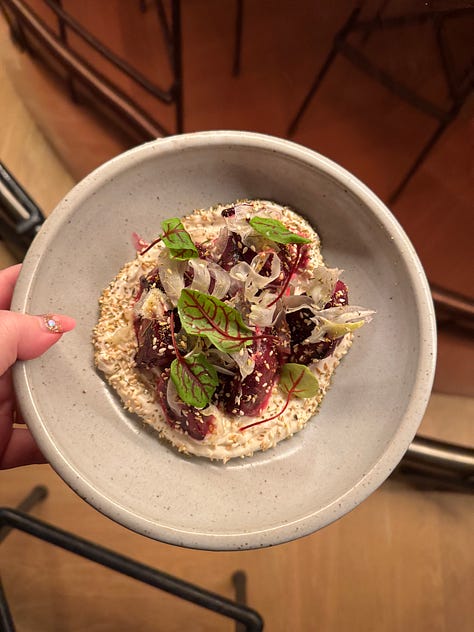
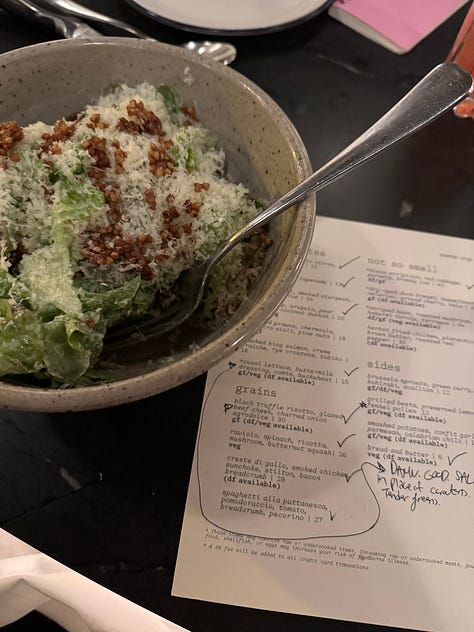
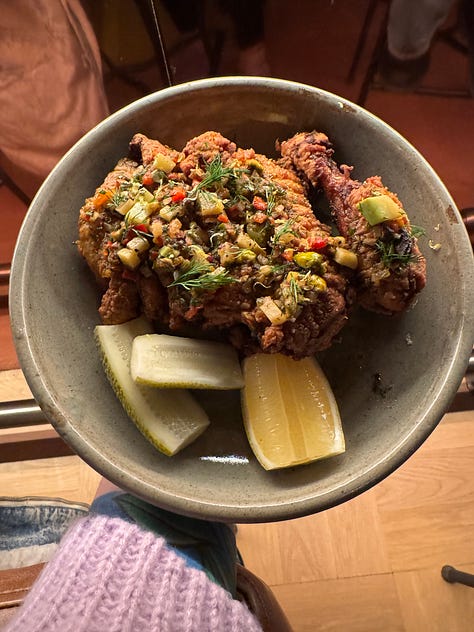
The fried chicken is on the main plates, not an appetizer, and for good reason: it’s giant and sharable. Brined with dill with a super crispy and craggy crust, it’s the best fried chicken in the state not just because it’s fried perfectly, but because it’s bursting with the taste of pickles and salt. It’s not just fried chicken—it’s a little weird. Like Herbst.
The pasta dishes are beautiful as always but are eclipsed by the risotto, of which I’ve had two kinds. The first was saffron with lamb, which felt soft and cozy and stuck to your ribs like a dish you might make after a long day shoveling snow. But…
Their most recent take on risotto is black truffle and glazed beef cheek with charred onion, which feels like the way Minnesotans might think of winter luxury when you remove the formal rules of fine dining: using an honest cut of meat cooked until it melts in your mouth like Wagyu against something so precious, that people sometimes die in pursuit of it.
That dish is deep like winter without any of the cliches of stone fruit or heavy sauces weighing it down. And it’s light like the best risottos, serving as a clear counterpoint to pastas with smoked chicken and stilton or raviolo with mushrooms and butternut squash. When I held it in my hands it felt like a warm bowl of porridge and the process of mixing the rustic herbs in reminded me of building a bowl of chili on the coldest days of the year. I took half of it home and poached an egg to top it in the morning, after the flavors had softened even more into each other, and I recommend you do that, too.
The N/A drinks are my favorite menu in the entire metro, but more on that later, when I write a play by play of what to pair with them for patio season in summer, as part of my new series Complete N/A Guide to ______, where I look at every cocktail on a menu singularly and review it. For now, just know you can order them all. They’re all excellent. But I’m partial to the bitter—just don’t order it if you don’t like bitter things. It’s in the name.
There are, of course, some kinks, like with any chef turnover—and notable service challenges that have plagued Herbst from the beginning.
One night, my boyfriend and I sat for 90 minutes with empty drink glasses. We would have worked our way through the entire N/A cocktail list if we had been asked if we wanted another. That same night, we had to chase down our check, something I only do when we’re sitting for a significant period of time.
Another night, it wasn’t clear who our server was, as the woman who introduced herself as our server was only seen again at the end of our meal and other people ran food to us. That night, it was hard to order drinks, too, because we didn’t want to make more work for people running food. We weren’t asked about ordering another round that night either, but this time, we did sheepishly put an order in for another round after it became clear we didn’t really have a server but a service team.
For the Christmas dinner, my boyfriend and I had duck that was obviously rushed, without fully rendered fat. At one point, I saw someone in the chef team in the kitchen say, “Shit,” and I think it’s because they realized they were down a duck with a ticking clock—in all honesty, we would have rather waited 10 more minutes. The flavor was great, but it needed more time. Still, it was the only protein dish out of 8 I’ve had (when you include second orders of the same dish) that had any errors on execution and on the same plate next to it was the best duck confit both my boyfriend and I ever had not by a little, but by a lot. The two other times I’ve had duck at Herbst, it was cooked perfectly.
The new side of smashed potatoes (it came on two weeks ago) has such a distinct flavor that it doesn’t fit into the menu and takes away from the other dishes—every other dish is far more delicate. I thought it had too much salt. My boyfriend just thought it was just too pungent.
But the pasta is always perfectly cooked. The proteins on the main menu have always been well executed. The ricotta toast is the star it always was. The soup is a stunner. All the other vegetable sides are special. And the dishes are almost always perfectly seasoned.
Dessert has been more of a challenge.
A preserved lemon semifreddo I had for dessert was overset, likely due to feedback from Moenster’s earlier years that sometimes his semifreddos were too soft. This one had the consistency of frozen Daiya cheesecake, which I ate a lot of in my vegan years, standing over the sink at 2 in the morning like a gremlin. But it was intensely flavorful with pickled pears on the side, making it daring and hearty and Midwestern in such a way that even if it was always overset, I’d order it again.
The pistachio financier I ordered once was overbaked, with a dry and crumby texture that was saved by everything else on the plate, including the most juicy blood oranges I’ve had yet this season and sour cream, plated perfectly on top like little gifts. The second one I had wasn’t saved by its surroundings—it was gummy and devoid of the lightness that is signature of a financier.
On dessert, I believe in time, they will find their way, but for now, the loss of their Pastry Chef Maria Beck echoes through the restaurant. Except for one dessert.
Bread pudding. Brandy caramel. Vanilla ice cream. Smoked cheddar white chocolate foam (yes). The kind of dessert you might like if the idea of cheese on apple pie appeals to you or if you always want to have the cheese course or if you like me believe that bleu cheese and squash might just be dessert. You might hate it. I love it.
Their most daring dessert on the menu but also their best, it feels to me like the true essence of the types of dessert Moenster can do if you just put your faith in him. And on things like smoked cheddar foam, I do.
Not overpowering but subtle, it takes a simple bread pudding and transforms it into a dessert fitting for the Midwest but often not found on menus in the Midwest as chefs don’t always trust us with the weird and whacky. Moenster surely does and we’re better for it.
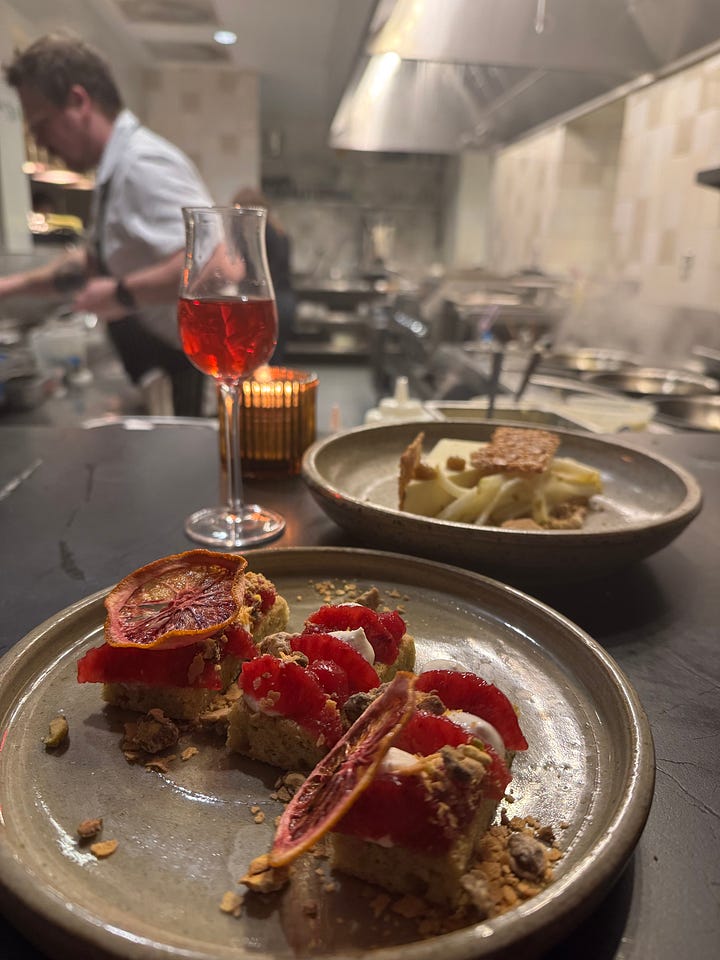
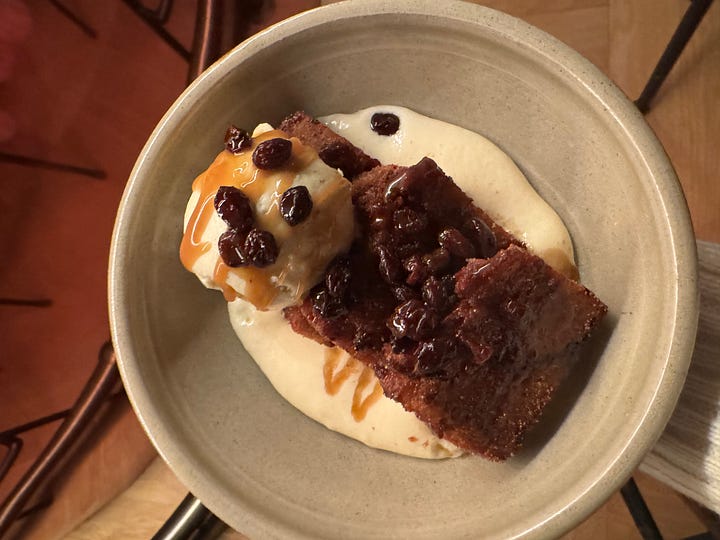
I am not saying they are errorless, I am saying that they are figuring it out—and that eating their mistakes has (for the most part) been a joy.
Because each week it gets better. Because each week they get closer. Because each week Herbst becomes more Herbst. Because even when a dish isn’t as intended, it still tastes pretty damn good, which isn’t true of a lot of restaurants when they make mistakes.
Restaurants with chef turn over at the top function not exactly like brand new restaurants, but similar enough. Day 180 is when you know what the restaurant looks like—and we’re at about day 90 right now. I believe they’ll work out the kinks, because I believe in this team.
I believe in them so much, I will be at their first brunch service if I’m in town (sometime after Valentine’s Day). And you wouldn’t catch me dead at most restaurant’s first brunch service. Look, you won’t even catch me dead at brunch ever.
On Sunday mornings, I am in bed with a reheated NY Bagel (actually from New York) in my PJs far away from the zoo that is brunch watching 90 Day Fiancé with my cats. But there’s something about this team where I want to go and be there when they work through their first service figuring out chicken and waffles (I haven’t seen the menu, but I’m begging for there to be chicken and waffles).
(I did go to Black Duck’s first brunch service on Saturday, which was my first “brunch” in probably six months, because they had a corn pancake made from my favorite heirloom corn, Farm + Sparrow, and you should honestly go. It was a beautiful first service.)
From front of house to back of house, I love the experience of the Herbst team—even when service is slow.
Front of house is funny, with one bartender joking with my boyfriend that he’d distract me to make sure next time he got some brussels and telling me that my boyfriend better get the dishes I took home for him—that he’ll check next time we come in that I did indeed give those dishes to him.
Once, before we even talked about drinks, my boyfriend and I were called “no proofers,” because we always order N/A drinks, a thing that shows care and intention.
People know my boyfriend Greg and I as an us to the point that when I came in solo, people asked after him. How was he? Was he working? Would I say hi to him? And while, yes, the team knew I was writing about them at this point (how can you not when a writer comes into your restaurant so many times in a few short months?), it truly is something I feel they would do for Greg regardless of who his girlfriend was. It’s obvious that he was missed in the dining room in such a way that it felt tender to me. It’s graduated from the place I used to go after I was stood up to our spot, not mine, and the team knows that.
And then there’s owner Angie, who when she is there is gracious and welcoming. One slow and very cold night when they were set to close early, she opened the door for us after we had a (terrible) meal elsewhere. “Are you open,” we asked when she unlocked it. “For you, we are,” she said, but that for you also included the four other people who came in after us, all of us red faced and wind swept as the kitchen went from being wiped down to being lit up again.
We were given broth that night, as a gift, which felt like the perfect way to warm our hands against the bitter cold. But we were also given such warm hospitality—a hard thing to do on slow nights in January.
Back of house is also a joy to watch. In the wake of all the chef changes, they had massive turnover up and down the brigade and at almost all levels of front of house. This team? It feels like it might stay.
Grant Wann is a rising cook who is a joy to watch in the kitchen.
Since I originally wrote my first draft, he was promoted to sous chef—or he starts in about a week as sous chef. But I want to show you what I wrote about him below before Chef Moenster (rightly) promoted him:
He’s not the sous chef, but in my opinion, he probably should be. When he speaks, people listen—and talk he does. Calling out orders and asking how things are looking, he has more than once fixed an error someone else made right in front of me. A tight command of the kitchen and knowledge about what dish is getting fired, sent to who, and when, he also graciously welcomes people into the chef’s counter no matter how weedsy the weeds get.
When there’s a spill or backlog or a kink in the otherwise well oiled machine, based on my experiences, it’s normally Wann who fixes it. That’s what I saw before Moenster and it’s what I see now, too. That’s what you want in a sous chef—someone who can get the line back on track, someone who temps the fried chicken, someone who tells someone to refire something if it’s not done properly.
One of the longest tenured staff (he’s been at Herbst for a little over a year), he has to believe in this place to stay despite all that head chef turnover. You can feel he cares. Not just that, you can feel his hustle.
When I think of Herbst now, I think not just of Moenster or the influence of Beck, Norgaard, or Simpson, but also Wann. Kitchens are never defined by just the head chef but largely are defined by the team’s ability to execute their vision. In that, he’s as much Herbst’s legacy as any of them. Chef Wann is a young chef who has an attention to detail and commitment to a restaurant that very few chefs have. Chef Moenster is so lucky to have him as his right hand.
Herbst also feels like Chef Ben Moenster. It feels like the culmination of years of working for others has finally allowed him to be himself.
After years of hanging out with the big restaurant groups (he was at Jester and Soigne for a combined 7 years), it seems he has found a home to be himself. His vision is clear and well executed: fun, sharable food cooked with the precision you might have found at La Belle Vie (another restaurant he worked in) in its glory days.
Chef Ben Moenster has brought Herbst roaring back to life. And in a metropolis of restaurants that sometimes feel like variations on the same very serious East Coast inspired restaurant concept, his food is exactly what we needed: Danish, Midwestern, lighthearted, born from struggle, full of pickles, daring, and fun.
Dill fried chicken made for sharing on a large plates section of a menu is fun. Green curry brussels sprouts are fun. Pickles in a dessert is fun. Duck dumplings are fun. Giving us a dressed up version of your grandma’s Christmas dinner is fun. It fits in with what Herbst always seemed like it was trying to be—from Herbst after dark to desserts full of surprises, Herbst has been set apart from other local restaurants because it feels like they want you specifically to find joy here.





